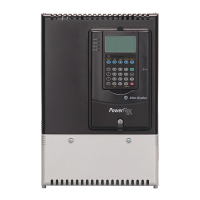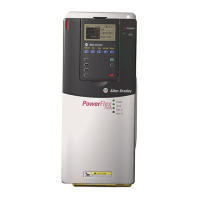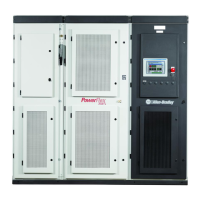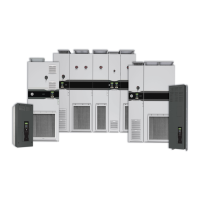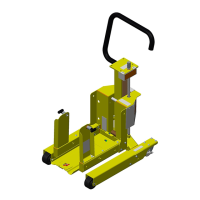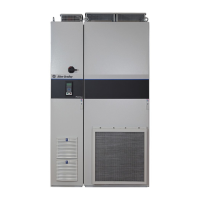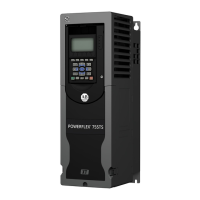
Do you have a question about the Rockwell Automation Allen-Bradley PowerFlex 40 FRN Series and is the answer not in the manual?
| Output Voltage | 0 to Input Voltage |
|---|---|
| Output Frequency Range | 0 to 400 Hz |
| Control Method | Sensorless Vector Control |
| Enclosure Type | IP20 (NEMA/UL Type Open) |
| Overload Capacity | 150% for 60 seconds |
| Control Inputs | Digital inputs, Analog inputs |
| Braking | Dynamic braking (optional DB resistor required) |
| Protection Features | Overvoltage, Undervoltage, Overcurrent, Ground Fault, Short Circuit |
Identifies practices or circumstances that can cause an explosion or lead to injury, death, or damage.
Alerts users to potential shock or burn hazards present on or inside the equipment.
Provides instructions for opening the drive's cover for IP20, NEMA/UL Type Open enclosures.
Details cover removal and installation steps for IP66, NEMA/UL Type 4X enclosures.
Discusses upright mounting, environmental protection, and minimum clearances for the drive.
Explains precautions for ungrounded systems and disconnecting MOV protective devices.
Lists input power conditions and corrective actions for proper drive operation.
Details safety ground, motor ground, and shield termination requirements.
Provides guidance on recommended fuses, circuit breakers, and their ratings.
Provides instructions and recommendations for motor cable types and wiring practices.
Lists specific types of shielded wire recommended for drive installations.
Describes the power terminal block, its connections, and specifications.
Offers important points and precautions for I/O wiring, including motor start/stop.
Illustrates typical control wiring configurations for various start/stop and direction methods.
Provides wiring examples for different input/output configurations.
Lists essential checks and procedures to perform before applying power to the drive.
Details the LED indicators, keys, and menu structure of the drive's integral keypad.
Provides step-by-step instructions for navigating and modifying drive parameters.
Describes the menu structure accessible via remote Human Interface Modules.
Menu for accessing detailed drive fault information and status.
Menu for accessing and displaying drive parameters in various lists.
Menu for saving or recalling drive configuration data (HIM sets).
Explains the types of parameters (ENUM, Numeric, Bit) and their markings.
Lists parameters organized by Display, Basic, and Advanced Program Groups.
Describes parameters related to monitoring drive status and output values.
Details parameters commonly used for drive configuration and setup.
Details advanced parameters for fine-tuning drive functions and performance.
Sets the condition that changes the state of the output relay contacts.
Sets the trip point for the digital output relay based on selected conditions.
Determines the operation of the programmable opto output 1.
Determines the on/off point for opto output 1 based on selected conditions.
Sets the rate of acceleration for all speed increases except jog.
Sets the rate of deceleration for all speed decreases except jog.
Provides the frequency command when the speed reference is set to internal frequency.
Provides a fixed frequency command value when digital inputs are set to Preset Frequencies.
Sets the acceleration and deceleration time when a jog command is issued.
Sets boost voltage and redefines the Volts per Hz curve for motor performance.
Sets boost voltage and redefines Volts per Hz curve for custom V/Hz mode.
Sets maximum output current allowed before current limiting occurs.
Selects the derating factor for the I2t overload function for motor protection.
Sets the maximum number of attempts to reset a fault and restart the drive.
Sets the time between restart attempts after a fault.
Resets a fault and clears the fault queue, primarily for network communications.
Sets the serial port data rate for the RS485 (DSI) port.
Sets the drive node address for the RS485 (DSI) port in a network connection.
Selects the drive's response to communication connection loss or errors.
Sets the time before implementing the communication loss action.
Sets transmission mode, data bits, parity, and stop bits for the RS485 (DSI) port.
Sets the analog input level corresponding to minimum frequency for 0-10V input.
Sets the analog input level corresponding to maximum frequency for 0-10V input.
Sets the analog input level corresponding to minimum frequency for 4-20mA input.
Sets the analog input level corresponding to maximum frequency for 4-20mA input.
Controls the operation of the drive voltage regulation.
Sets maximum output current allowed when current limiting is active.
Selects drive action when an analog input signal loss is detected.
Enables or disables bipolar control for analog inputs.
Enables or disables sensorless vector control operation.
Sets the motor nameplate rated full load amps.
Provides an automatic method for setting motor parameters for sensorless vector.
Sets the maximum positive value added to speed reference in PID trim mode.
Sets the maximum positive value subtracted from speed reference in PID trim mode.
Enables PID mode and selects the source of the PID reference.
Selects the source of the PID feedback signal.
Sets the proportional gain for the PID loop.
Sets the integral gain for the PID loop.
Sets the differential gain for the PID loop.
Provides an internal fixed value for the process setpoint in PID mode.
Sets the range, in percent, of the PID reference that the drive will ignore.
Sets the value used to preload the integral component on start or enable.
Parameter for defining the first step in StepLogic programming.
Defines accel/decel, output state, and command direction for StepLogic steps.
Defines conditions for jumping to a specific StepLogic step or ending the program.
Defines logic conditions for transitioning between StepLogic steps.
Sets the time to remain in each StepLogic step when timed transitions are used.
Sets time before relay/opto output energizes for electromagnetic brake control.
Sets time before relay/opto output de-energizes for electromagnetic brake control.
Sets the DC bus voltage threshold for Dynamic Brake operation.
Determines if parameter changes are saved to NVS or RAM only.
Sets time after power-up before analog signal loss is detected.
Sets level of additional filtering for analog input signals.
Changes the sign of the PID error for specific control behaviors.
An alphabetical listing of parameters, their numbers, groups, and page references.
Explains how drive condition or state is monitored and indicated via the keypad.
Defines faults as conditions that stop the drive and categorizes them by type.
Describes how faults are visually indicated on the drive's integral keypad.
Provides steps for manually clearing faults after addressing the cause.
Details procedures for automatically clearing specific fault types and restarting.
Explains the feature allowing automatic fault reset and start attempts.
Lists fault types, their descriptions, and recommended actions for resolution.
Provides troubleshooting guidance for common drive issues and their solutions.
Troubleshooting steps for drives not starting via terminal block inputs.
Troubleshooting steps for drives not starting via the integral keypad.
Troubleshooting steps for issues related to speed command response.
Troubleshooting steps for problems with motor acceleration.
Troubleshooting steps for issues related to unstable motor operation.
Troubleshooting steps for issues with motor direction control.
Troubleshooting steps for when the drive fails to power up.
Provides recommended AC line input fuse and circuit breaker information.
Lists technical specifications for the PowerFlex 40 drive series.
Details electrical ratings for digital and analog inputs/outputs.
Lists safety and regulatory approvals for the drive.
Details specifications for programmable output relays and opto outputs.
Lists protective features including overload, overvoltage, and overcurrent protection.
Lists environmental specifications such as altitude, temperature, and atmosphere.
Lists control specifications like carrier frequency, accuracy, and I/O ranges.
Lists electrical specifications such as voltage tolerance and input phases.
Provides a table for selecting PowerFlex 40 drives based on ratings and enclosure.
Lists dynamic brake module part numbers, resistance, and weight.
Lists line reactor part numbers, dimensions, and weight.
Lists DC bus inductor part numbers and MTE catalog numbers.
Lists EMC line filter part numbers based on drive ratings and cable length.
Lists catalog numbers for HIM options, accessories, and cables.
Lists part numbers for IP30/NEMA 1/UL Type 1 kits for drives and communication options.
Lists catalog numbers for communication adapters, cables, and software.
Provides a table of drive ratings and dimensions by frame size.
Shows dimensions for IP20, NEMA/UL Type Open drives.
Shows dimensions for IP30/NEMA 1/UL Type 1 kits.
Shows dimensions for PowerFlex 40 Flange Mount drives.
Shows cutout dimensions for PowerFlex 40 Flange Mount drives.
Shows dimensions for PowerFlex 40 Replacement Plate drives.
Shows dimensions for IP66, NEMA Type/UL Type 4X drives.
Shows dimensions for Dynamic Brake Modules.
Shows dimensions for Bulletin 1321-3R Series Line Reactors.
Shows dimensions for Frame B EMC Line Filters.
Shows dimensions for Frame C EMC Line Filters.
Shows dimensions for Remote (Panel Mount) Small HIM.
Shows dimensions for NEMA Type 1 Bezel.
Describes the network wiring configuration for RS485 (DSI) protocol.
Lists PowerFlex 40 parameters used to configure the drive for network operation.
Lists Modbus function codes supported by the drive's peripheral interface.
Details how to write logic commands via the network using Function Code 06.
Details how to write speed references via the network using Function Code 06.
Details how to read logic status data via the network using Function Code 03.
Details how to read drive feedback (output frequency) via the network.
Details how to read drive error codes via the network using Function Code 03.
Explains how to access and modify drive parameters via Modbus register addresses.
Guidelines for connecting peripherals using the RJ45 DSI splitter cable.
Lists various DSI cable accessories like splitter cables and adapters.
Wiring example for connecting a single temporary peripheral to the drive.
Wiring example for connecting one temporary and one permanent peripheral.
Wiring example for connecting two permanent peripherals to the drive.
Wiring example for connecting multiple drives to an RS-485 network.
Sequences preset speeds based on programmed logic, digital inputs, and timers.
Uses digital inputs and outputs for basic logic functions like AND, OR, NOR.
Uses digital inputs and outputs to control timer functions for timed outputs.
Uses digital inputs and outputs to control counter functions for counting events.
Details configuring StepLogic using speed references and time for each step.
Explains using digital inputs and outputs for logic transitions in StepLogic.
Explains how inputs and outputs control the timer function and its parameters.
Explains how inputs and outputs control the counter function and its parameters.
Provides code descriptions for StepLogic parameters.
Defines accel/decel, output state, and command direction for StepLogic steps.
Defines conditions for jumping to a specific StepLogic step or ending the program.
Defines logic conditions for transitioning between StepLogic steps.
Explains the built-in PID control loop and its function in maintaining a process set point.
Describes PID configuration where PID output becomes the entire frequency command.
Describes PID configuration where PID output is added to the speed reference.
Explains how to select PID reference sources and PID feedback sources.
Explains how to scale analog signals for PID reference.
Explains inverting PID error sign for 4-20mA signals.
Explains setting a range the drive ignores for PID output.
Explains setting a preload value for the PID integral component on start or enable.
Explains parameters to limit PID output frequency in trim mode.
Details the proportional, integral, and differential gains of the PID regulator.
Step-by-step guide for tuning PID proportional, integral, and differential gains.





